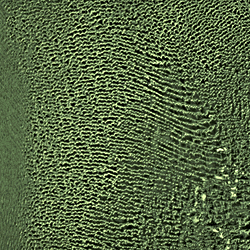 |
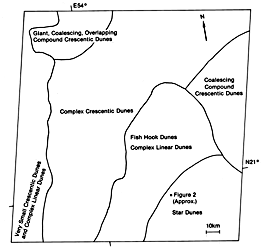 |
|---|---|
| Plate E-2 | Map |
 |
 |
|---|---|
| Plate E-2 | Map |
The largest active sand sea on Earth, with an area of 560 000 km2, is the Rub´al Khali, the Empty Quarter of southern Saudi Arabia. The eastern Empty Quarter is on a 300- km wide northeast plunging elongate basin of Tertiary age (Powers et al., 1966). The western desert overlies the Hadramawt segment of the Arabian Shelf, which has an average dip of 0°20´ (Powers et al., 1966). The Empty Quarter is covered by an almost continuous eolian accumulation with only occasional remnants of older relief, gravel, or sabkha flats (Anton, 1983). Breed et al. (1979a) divide the Empty Quarter into three principal areas. The western half of the desert consists mainly of northeast-southwest-trending linear dunes. Star dunes dominate the east and south; crescentic dunes are in the northeast. All three of these dune regimes may be seen within this scene in eastern Saudi Arabia.
Most of the star dunes are of equal size and are equidistant. These are also noted on the bottom right of Figure E-2.1, a Return-Beam Vidicon (RBV) image that covers the bottom left of the Plate. Proceeding westward in this image, observe the elongation of the arms of the star dunes. The stoss side (gentle side, facing the dominant wind direction) of the dune is extended. Some of the dunes have coalesced into linear dunes with well-defined crescentic hooks at the western end. These are sometimes called fishhook dunes. The fishhook dunes are connected by northwest sand streaks.
| Figure E-2.1 | Figure E-2.2 |
|---|---|
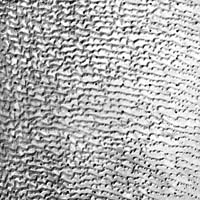 |
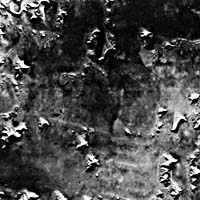 |
Figure E-2.2, an aerial photograph, shows a 15-km wide area of the complex star dunes that occur in the lower right of the Plate. Note the crescentic dunes on the interdune areas and the linear dunes on the arms. A few of the star dunes in the photograph are isolated, but most are surrounded by small dunes.
Complex crescentic dunes, about 100 m tall, with star dunes on their faces dominate the northern half of the scene. Breed et al. (1979a) found that these crescentic dunes have a mean width (horn to horn) of 2.8 km, a mean length of 2.1 km, and a spacing of 2.6 km.
The amount of sand in this sand sea increases greatly to the northwest in this Plate scene. The dunes in this area are much longer and are coalescing. Sand, rather than bedrock or gravel, underlies the crescentic dunes. Where the dunes overlap, the sand sea overlies sand instead of gravel or bedrock. Compare this transition to the appearance of other sand seas in this chapter.
| Figure E-2.3 | Figure E-2.4 |
|---|---|
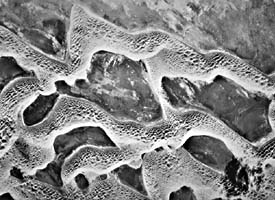 |
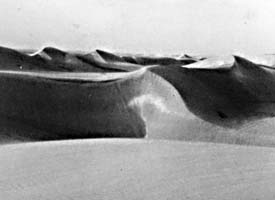 |
Figure E-2.3 is an aerial photograph of a 5-km wide area of compound crescentic dunes about 50 km north of this scene. The main slipfaces of these giant dunes are to the southeast. Note the interruption of the smaller crescentic dunes on their stoss sides where they coalesce. Breed and Grow (1979) call attention to small simple crescentic dunes on some of the dark interdune areas that they consider to be interdune sabkhas. Sabkhas, salt- encrusted playas of clay, silt, or sand, are seen in the light areas at the bottom right of the Plate.
In this Plate scene and the far left margin of Figure E-2.1, the pattern sharply changes from large crescentic dunes to the east to sand sheets and small crescentic dunes to the west. Linear dunes appear near the bottom left of the Plate and dominate the region directly to the west. A change in relief may have caused this shift; this is speculative owing to lack of adequate topographic data.
In an area northwest of this Plate scene, Breed et al. (1979a) suggest that the small crescentic dunes may be migrating southward and overriding the larger compound crescentic dunes. If this is the case, it may mean that more sand became available rather rapidly at the source area, perhaps because of regional uplift or climatic changes, and the sand sea has not yet reached equilibrium.
Figure E-2.4 illustrates typical Empty Quarter dunes as seen at ground level. The light areas are very transient patches of salt. Landsat 1111-06195-7, November 11, 1972.
Continue to Plate E-3| Chapter 8 Table of Contents.| Return to Home Page| Complete Table of Contents